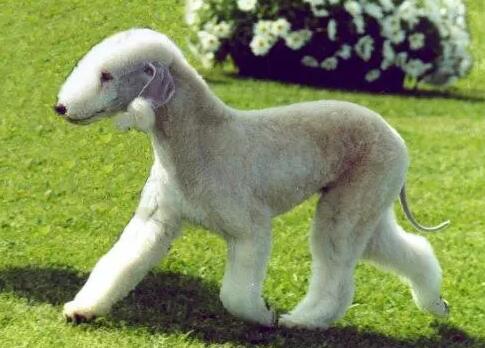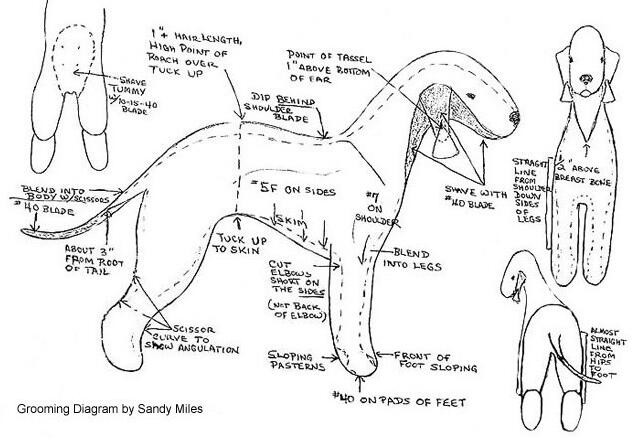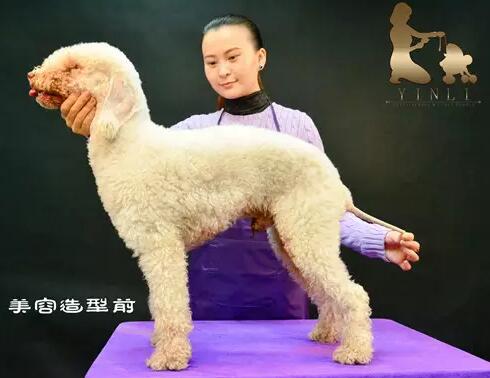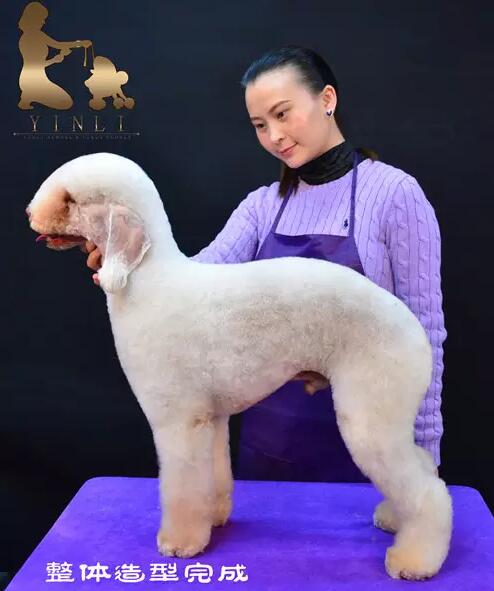
Species Description:
Its ancestors were a mix of Whippet, Otterhound and Dandie Dinmont, and it was named after Bellington in the English mountains. It was also used for gambling and fighting, and later the upper class made it fashionable and popular, gradually becoming a domestic pet. There is a kind of sheep or dog mixed feeling, the whole body bristles, soft hair intermingled curly. With long feet and crowned hair on its head, it looks like a small sheep with a lively character, and its coat colors are blue, gray, beige, blue-brown, red-brown, dark gray, and so on. It is also very color-changing, which is also its charm. When it is small, it is black or brown, and starts to change color after two months, and its color tends to be stable at one and a half years old. For grooming, the coat is trimmed into its unique sleek style, the Belington look.
Breed Standard:
Head: The head is covered with a large number of cephalic buns, almost entirely white.
Skull: Narrow, but deep and rounded.
Stop: There must be no stop: a continuous straight line from the shen bone to the nose mirror.
Face: Large, well-defined nostrils. Blue and teal dogs must have black noses, while liver and pale yellow-brown dogs must have brown noses.
MOUTH: Plump under the eyes.
Lips: Tight lips, no floating lips.
Jaw/Teeth: The jaw is long and tapering. Teeth long and strong. Shear bite, in which the upper teeth clasp the lower teeth, giving the jaw a square shape.
Eyes: Small, bright and sunken. Ideally the eyes should be triangular in shape. Blue dog eyes are dark, blue and teal eyes are brighter with an amber light, and liver and light fawn eyes are hazel.
Ears: Appropriately sized, hazelnut shaped, positioned low and hanging flat on either side of the cheeks. Ears are thin and covered with a layer of down. The tips of the ears are covered with soft, trimmed hairs that form a silky fringe.
Neck: Long, tapering, without rasping. It extends upward from the shoulders, and the head can be held high.
Body: Muscular and extremely flexible. Length is slightly greater than height.
Back: Natural upward arch from the waist up.
Waist: Curved, curved backline just above the waist.
Chest: Deep and rather wide. The ribs are flat and reach the elbow in depth.
Ventral line: The arching waist gives a certain fold to the ventral line.
Tail: Tail of moderate length, thick at the root, tapering to a graceful curl. It is low in position and cannot be lifted over the back.
Limbs: Forequarters legs straight, spaced a little wider apart on the chest than between foot and claw. The hindquarters are muscular and of moderate length. The hind legs are somewhat longer than the front legs. The paws are long rabbit feet with compact paws.
Gait/Movement: Capable of darting at high speeds and possesses this ability when given up. Movement is very characteristic, with a somewhat slow and brisk gait in a slow march; running in a slightly paddling position.
Coat: Very distinctive. Soft hairs mixed with hard hairs that grow naturally from the skin, but don’t feel like wire. The hair is very frizzy, especially on the head and face.
Color: Blue, liver or yellowish brown with or without teal. Brown markings are encouraged.
Size & Weight: The horse’s shoulder height is about 41 centimeters =. For bitches, it is allowed to be slightly lower, while for males it can be slightly higher. Weight is between 8.2 and 10.4 kilograms.
Cosmetic Standards:

Coat standards should be trimmed to 62.5px long when shown, with slightly longer leg hair.
1. Using a 1mm blade, start at 62.5px above the ear tip and trim to an inverted V shape. (Except for the spiky hairs) Carefully trim the excess long hairs around the edge of the ear, comb the spiky hairs first and then trim them to 2~75px above the ear tip.
2. From 75px below the throat knot to the base of the ear, trim with a 1mm blade to form a U or V shape. Trim the root of the ear, the corner of the eye and the corner of the mouth to form an imaginary line. Cut off all the hair on the lower jaw, all the way down to the bottom of the nose.
3. The hair from the root to 1/3 of the tail should be trimmed against the hair. And the inside of the tail, from the root to the tip all pushed off. After trimming the perianal hair, use the clippers to organize the boundary of each part, so that each part is coordinated and natural.
4, male dogs abdomen, hind limbs of the connection of the inner trimmed into a V-shaped, while female dogs are trimmed to the navel can be.
5. Trim the front and back meaty toes without trimming the hair between the toes. The front side of the foot is trimmed so that the toenails can be seen, and the back side is trimmed in a rounded shape.
6. The length of the hair from the tail root to the waist, back and shoulder rump should be even. Take the round point of the anal button and trim the back into an arch.
7. The lateral abdominal hair was left 37.5px long so that the carapace was trimmed to an oval cross-section.
8. The lower chest is trimmed to the elbow in order to make the chest look deeper.
9. Trim from the hip to the hock in an arc, with the heel at a right angle to the ground. The front of the foot is trimmed until the toenails are visible. The forelegs and hindlegs are cylindrical no matter what angle they are viewed from.
10, from the root of the ear, through the shoulder to the front side of the forelimb, trimmed in a straight line. The clipping method of the hind limbs is the same as that of the front limbs.
11. Face
A. Trim the roots of the ears, the corners of the eyes, and the corners of the mouth, and cut the sides parallel.
B. Trim the top part of the head (in front of the ears) in a horizontal straight line.
C. Trim the sides of the head to give the head an oval shape.
Viewed from behind, the back of the head to the bottom of the face is an elegant oval. When viewed from the side, the front roots of the ears are at their highest point and the mouth is trimmed as short as possible.
12. From the back of the head, through the neck to the back in a perfect curve, and the tip of the nose through the top of the head to the back of the head in an oval head shape. In the shoulder blades, the male dog is trimmed to be more pointed, the female dog is trimmed to be more rounded, and the back line must be curved.
13. Leave a 5mm wide line at the boundary between the neck and chest, and trim it with shears.
14, the eyes are invisible from the front and can only be seen from the side. Hair around the eyes is trimmed to a triangle shape, and thinning scissors are used to trim at the boundaries of each part of the face.



